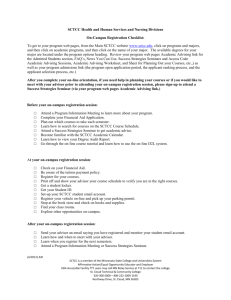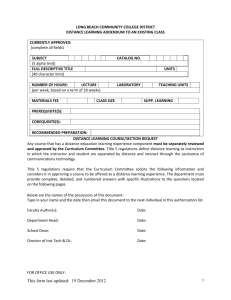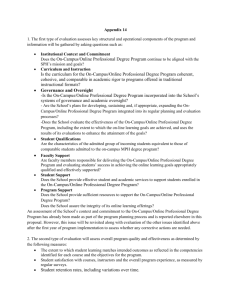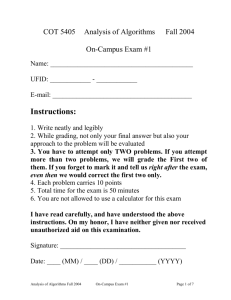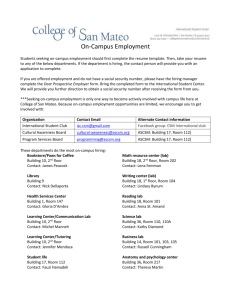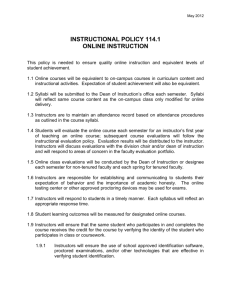article as PDF - Journal of Interactive Online Learning
advertisement
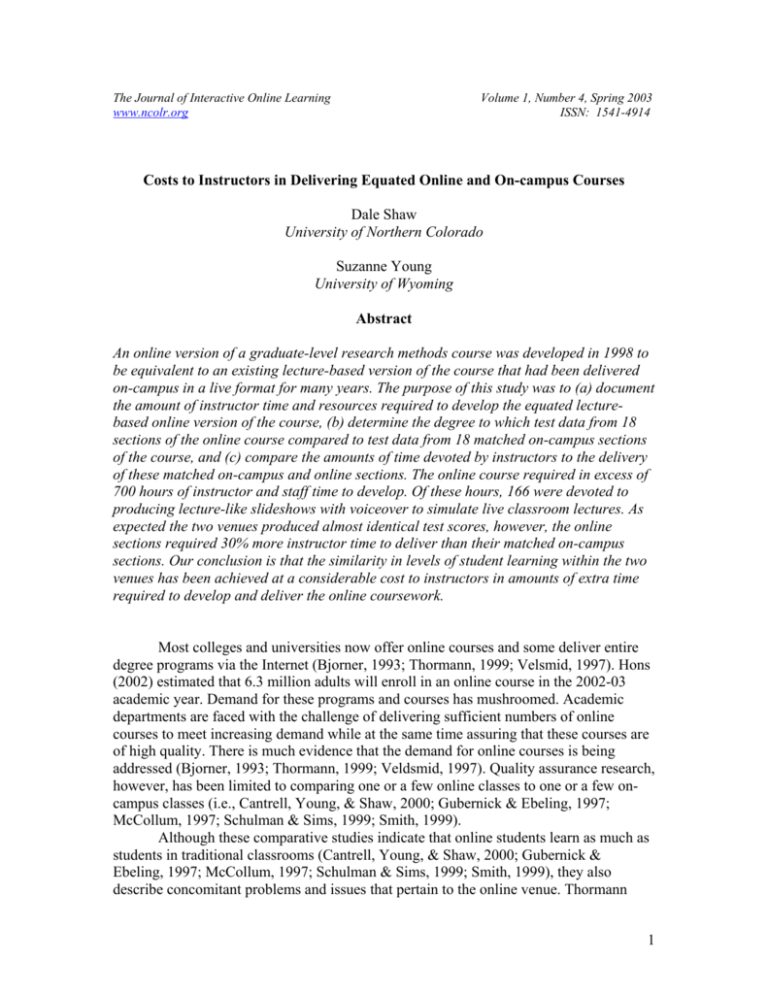
The Journal of Interactive Online Learning www.ncolr.org Volume 1, Number 4, Spring 2003 ISSN: 1541-4914 Costs to Instructors in Delivering Equated Online and On-campus Courses Dale Shaw University of Northern Colorado Suzanne Young University of Wyoming Abstract An online version of a graduate-level research methods course was developed in 1998 to be equivalent to an existing lecture-based version of the course that had been delivered on-campus in a live format for many years. The purpose of this study was to (a) document the amount of instructor time and resources required to develop the equated lecturebased online version of the course, (b) determine the degree to which test data from 18 sections of the online course compared to test data from 18 matched on-campus sections of the course, and (c) compare the amounts of time devoted by instructors to the delivery of these matched on-campus and online sections. The online course required in excess of 700 hours of instructor and staff time to develop. Of these hours, 166 were devoted to producing lecture-like slideshows with voiceover to simulate live classroom lectures. As expected the two venues produced almost identical test scores, however, the online sections required 30% more instructor time to deliver than their matched on-campus sections. Our conclusion is that the similarity in levels of student learning within the two venues has been achieved at a considerable cost to instructors in amounts of extra time required to develop and deliver the online coursework. Most colleges and universities now offer online courses and some deliver entire degree programs via the Internet (Bjorner, 1993; Thormann, 1999; Velsmid, 1997). Hons (2002) estimated that 6.3 million adults will enroll in an online course in the 2002-03 academic year. Demand for these programs and courses has mushroomed. Academic departments are faced with the challenge of delivering sufficient numbers of online courses to meet increasing demand while at the same time assuring that these courses are of high quality. There is much evidence that the demand for online courses is being addressed (Bjorner, 1993; Thormann, 1999; Veldsmid, 1997). Quality assurance research, however, has been limited to comparing one or a few online classes to one or a few oncampus classes (i.e., Cantrell, Young, & Shaw, 2000; Gubernick & Ebeling, 1997; McCollum, 1997; Schulman & Sims, 1999; Smith, 1999). Although these comparative studies indicate that online students learn as much as students in traditional classrooms (Cantrell, Young, & Shaw, 2000; Gubernick & Ebeling, 1997; McCollum, 1997; Schulman & Sims, 1999; Smith, 1999), they also describe concomitant problems and issues that pertain to the online venue. Thormann 1 (1999) reported that online participants routinely expressed concern about the amount of time required for e-mail, the reliance on technology that was not always reliable, and the lack of face-to-face interaction between students and the instructor. Cantrell, Young, and Shaw (2000) reported that in some courses instructors and students are taking on different roles in their learning than they have been accustomed to, and that they are handling these roles with varying degrees of interest and success. For example, students might be asked to moderate a threaded discussion or lead a chatroom conversation. They may be doing so for the first time and they may or may not be good leaders. At the same time instructors are finding their roles to be considerably more facilitative and less instructional during the delivery of the course (Cantrell, Young, & Shaw, 2000). It appears that although the online and on-campus venues may produce comparable student learning, it may be at the expense of extra time and effort required of the online students and instructors. This study was initiated in 1998 in an effort to carefully document the nature and extent of some of these extra costs to instructors. It was conceived as part of a larger project to produce a highly viable online version of a graduate-level research methods course to be delivered multiple times. The purpose of the study was to (a) provide an accurate accounting of the amount of instructor time and other resources required to develop the online course, (b) determine the degree to which test data from the online course matched test data from equated on-campus sections of the course, and (c) compare the amounts of time spent by instructors who taught equated on-campus and online sections of the course. To facilitate these planned comparisons, the online course was developed in such a way so as to match existing on-campus courses to the greatest extent possible. Background The On-campus Courses For years graduate research methods courses have been required of all graduate students at the University of Northern Colorado (UNC) and the University of Wyoming (UW). The UW catalog description of the course reads very much like that of UNC’s which states: “Principles of research, design, and analysis. Read and critique published research. Required of all first year graduate students.” The course deals with the formulation of workable research questions and hypotheses, acquisition of library resources and search information, descriptive and inferential statistics, measurement issues including the reliability and validity of measures, and research designs including basic experimental designs. Currently, content dealing with qualitative methodology, single-subject research, historical research, case study, and ethnography is introduced in the courses but is given minimal treatment. One or more sections of the courses are delivered on-campus each semester at both universities. The sections are delivered in a lecture format by senior faculty with substantial research experience. Students who take the course are in masters programs in various fields of education, psychology, health and human sciences, and speech pathology. 2 The Online Course During the summer of 1998, in preparation for the development of the online course, the authors developed a joint syllabus for the delivery of their sections of oncampus research methods courses at both institutions. Beginning in the fall of 1998, the authors’ on-campus sections were taught using this joint syllabus with identical course materials, reading and problem assignments, paper requirements, tests, and lecture outlines. The online version of the course was developed by the authors in the summer and fall semesters of 1998. It was based on the joint on-campus syllabus and delivered for the first time at both universities in the spring of 1999. Since that time, the course has been offered three times a year at UNC and twice a year at UW, 18 times in all. Equating the online version of the course to the on-campus versions was accomplished by building the online course around the joint syllabus developed for the on-campus versions. In addition, the same textbook was required (Introduction to Research in Education, by Ary, Jacobs, & Razavieh, 5th ed.), the same readings and problem assignments from the textbook were required, the same tests were administered, the same articles were critiqued, and the same papers and projects were required. The most challenging feature of the on-campus course to duplicate was its lecture format. It had been delivered by lecture for years, all other current instructors were delivering it by lecture, and the authors were delivering it by lecture as well. This lecture format was matched to a substantial degree in the online course by using slideshows with voiceover to cover the material in each unit. Students could download these lecture-like slideshows and play them as often as they liked. Units were organized around textbook chapters and consisted of virtually all material presented in one or two chapters of the textbook. In all, there were eight units with four tests. Each test covered two units. In its current format, which has evolved over the past four years, the online course spans 13 weeks and has a highly structured format. Each week there are assigned readings, assigned slideshows to download and study, exercise assignments, and critiques of articles to perform. Approximately every third week there is a timed online test to take. These tests consist of 50 multiple-choice items that, for the most part, tap students’ ability to apply concepts and to reason with the new information they are studying. Students are expected to participate in a threaded discussion each week that is focused on the important topics in the textbook readings. They also read and critique research articles, analyze datasets, and use online library resources. A paper describing a proposed research study is required at the end of the course. Results Course Development We recorded the amounts of time we spent in all aspects of course development. Preliminary activities included several university-sponsored meetings with faculty and administrators to address issues regarding who would develop courses, financial and staff support availability, vendor choice, and course ownership. Training sessions were provided to prospective instructors by the university and the vendor. In all, approximately 3 54 hours of instructor time (excluding travel time) was devoted to these preliminary activities (see Table 1). ________________________________________________________________________ Table 1 Hours Spent Developing the Online Course* Activity Hours spent______ Instructors Help staff Preliminaries Initial University meetings (concepts/support/procedures) Meetings with Deans/Provost—agreements re. ownership Trainings—how to place a course on the vendor’s site Instructor meetings to parcel out chores/coordinate efforts Course design—composition of units/slideshows/etc. TOTAL 19 9 36 16 __78 158 3 8 5 3 19 90 98 68 84 61 Development (Creating the course for the first offering) Writing and organizing Units (8 Units consisting of 14 textbook chapters and augmenting material) Writing and rehearsing slideshows Recording and re-recording slideshows Test bank—creation/modification/input Preparing online syllabus/directions for using course e-mail, threaded discussions, chatrooms, etc. Communication with vendor/loading the course Checking and correcting all materials after being loaded Technical problems (time spent trying to get something to work with no fruitful results) Additional development tasks that became evident during the first offering TOTAL 30 27 49 5 9 46 14 __28 520 12 101 * Help staff hours include secretarial and student worker hours, but not hours of help provided by university or vendor technical staff. We decided early on to make heavy use of slideshows with voiceover to present essential content in a lecture-like format. We spent approximately 47 hours in meeting together (for a total of 94 instructor hours) to design the layout of the course, decide on the number and nature of the units, organize the material within the units, design the structure and basic format for the slideshows, and divide up the remaining developmental chores. Writing the text for the unit assignments, threaded discussions, and slideshows required 188 hours, recording the slideshows took 68 hours, preparing the online syllabus and instructions for using course features took 30 hours, and dealing with miscellaneous developmental tasks that became evident during our first deliveries of the course required 4 an additional 28 hours. We spent 168 hours working on a test bank for use with both the online and on-campus courses. Half of this amount of time (84 hours) is reported in Table 1. We wrote about 30% of the items in the test bank and used items supplied with the Ary, Jacobs, and Razavieh textbook, many of which we edited. We had some staff assistance for tasks that required substantial keyboarding (120 hours). In total, there were 520 instructor hours and 101 staff hours devoted to the development of the course. In 1998 when we began this project, we had hoped to be able to use video clips to deliver online lectures in an effort to match the online course more closely to the lecture based on-campus classes. At that time, inclusion of a large number of video clips in an online course was not feasible for several technical reasons, including potential problems students might have in downloading and storing these large files. However, it was anticipated that within a very short time, video clips would be feasible. Our plan was to convert from a slideshow-based format to a video clip-based format at that time. Our greatest disappointment over the duration of this project has been that delivering an online course with a large number of video clips is still not feasible today. Comparison of Online and On-campus Sections Since the spring of 1999, 18 sections of the course have been offered in semesters in which one or both of the authors also taught a matched on-campus section of the course. Table 2 contains the amount of instructor time devoted to each of the online and oncampus sections. On average the online sections required 191 hours of instructor time to deliver. The on-campus courses required an average of 135 hours. This difference in means of 56 hours over 18 matched pairs of sections is statistically significant (t = 10.01, p < .0001). The online sections have required 30% more instructor time to deliver than equated on-campus sections. Table 2 Instructor Hours and Average Test Scores for Matched Online and On-Campus Sections Semester/ University Spring ’99 UW Spring ’99 UNC Summer ’99 UNC Fall ’99 UW Fall ’99 UNC Spring ’00 UW Spring ’00 UNC Summer ’00 UNC Fall ’00 UW Fall ’00 UNC Spring ’01 UW Spring ’01 UNC Summer ’01 UNC Instructor Hours Online On-campus 219 209 177 188 219 186 163 181 185 160 229 265 191 148 133 143 140 130 122 145 128 141 118 164 149 120 Total Test Score Average Online On-Campus 87.63 86.61 83.33 85.58 87.12 89.00 87.67 84.81 86.98 83.84 90.50 88.83 84.44 85.66 87.13 84.95 83.93 86.39 87.78 84.71 84.32 86.12 84.42 86.62 87.37 82.00 5 Fall ’01 UW Fall ’01 UNC Spring ’02 UW Spring ’02 UNC Summer ‘02 UNC 176 163 161 183 175 133 122 131 138 130 87.27 85.22 85.21 87.22 84.96 86.81 84.81 83.79 84.81 86.25 Means 190.56 135.28 86.46 85.44 Difference in means 55.28 1.02 t 10.01 2.98 p <.0001 <.01 ________________________________________________________________________ A substantial portion of the online instructor hours each semester was devoted to e-mail communication with the students in the class. Some e-mails were general announcements and course status reports sent by the instructor to the entire class. However, most of the e-mails were in response to individual student questions about content, procedural matters, technology problems and troubleshooting, queries regarding relaxing deadlines, tests and test answers, concern for one’s grade, illness, and make-up work. We observed that much of the additional 30% of time required for the online sections over on-campus sections accrued essentially from the high volume of e-mail. Tests were routinely modified from semester to semester for the purposes of maintaining some degree of test security. We obtained 18 sets of test scores from identical tests given in the matched online and on-campus sections of the course. Student composite test averages for each pair of matched online and on-campus sections are presented in Table 2. Fourteen of the 18 online sections outperformed their on-campus counterpart. The average student composite test score in all of the online sections was 86.46 and in all of the live sections was 85.44. This difference of one point is statistically significant (t = 2.98, p < .01), but of little practical consequence. Essentially the two venues produced comparable levels of student learning. During the 4 years that we have been delivering the course online, the quality of technical support has steadily improved and problems of all kinds have become fewer. Out-of-date computer equipment and slow phone lines in rural parts of the country still play havoc with the student who does not have high-grade equipment and high-speed Internet connections. Persistent problems that online students complain about every semester are slow download times (only for a few students), availability of material at bookstores, and troubleshooting technological problems. Online students identify the best features of the online course as the meaningful discussions that take place in the threaded discussions and being able to work at home (and not commute). They say the worst features are lack of live interaction with others, chatroom discussions where the instructor is not present, and any aspect of online testing. In particular, they cite issues related to test security features, the timed nature of the tests, and the anxiety they experience when they have technological difficulties during the test. They also tell us that the course is very challenging, especially as an online course. The on-campus students who have experienced an online course previously comment to a person that they are pleased to have taken the course live rather than online. They feel that the course would have been more challenging had they taken it online. 6 Summary and Discussion In this study, hundreds of hours were invested in developing and delivering an online course matched to the greatest extent possible to a lecture based on-campus course. Almost identical test results from 18 matched sections of online and on-campus sections taught by the same instructors over a 4-year period attest to the comparability of the two venues with regard to student learning. With this weight of evidence, meaningful comparisons of the amount of instructor time required to deliver courses in the two venues are possible. Four findings from this study are presented below with accompanying discussion. 1. The development of this 3-semester hour online course required in excess of 700 hours of instructor and staff time (excluding technical service support time). Our choice of a slideshow format required 166 hours of instructor time to plan and produce the shows. While 700 hours of development time may not be typical for most 3-semester hour courses, it may be more so for video clip, streaming video, or slideshow-based courses. 2. Mean test scores obtained over 18 pairs of matched online and on-campus sections, favored the online sections only slightly. Essentially the two venues have been producing comparable levels of student learning. Our finding of comparable levels of student learning matches the findings of other researchers who have compared levels of student learning in online and on-campus courses (Gubernick & Ebeling, 1997; McCollum, 1997; Schulman & Sims, 1999; Smith, 1999). 3. Course delivery of online sections has required 30% more instructor time than for on-campus sections. The majority of the extra time required for delivery is devoted to e-mail communication with students. We found that our attempts to reduce e-mail communication invariably were met with increased student concerns about interaction and a lack of feeling connected to the class. Further, as we ventured into course content that was difficult for students (such as statistics and experimental design), e-mail proliferated substantially. Delivery of an online section of this course may produce the same student learning as an on-campus section, but the cost to the instructor is an expenditure of an additional 30 percent more time to deliver the online course than to deliver an on-campus course. 4. Of all course features, online students liked best that they did not have to commute to campus. However, many acknowledged that the course was challenging, especially in the online venue. In addition, on-campus students who had previously experienced a different online course indicated that they were pleased to have taken the course live rather than online. They believed that the course would have been more challenging had they taken it online. In conclusion, this study does present substantial evidence based on the comparisons of 18 matched sections that indeed online and live venues can produce comparable student learning. However, in this case, the similarity in levels of student learning within the two venues has been achieved at a considerable cost to instructors in amounts of extra time required to develop and deliver the online coursework. Further, students seem to agree that the online venue is the more challenging of the two venues for this particular content. 7 References Ary, D., Jacobs, C. J., & Razavieh, A. (1996). Introduction to Research in Education (5th ed.). New York: Harcourt Brace. Bjorner, S. (1993). The virtual college classroom. Link-up, 10, 21-23. Cantrell, P. P., Young, S., & Shaw, D. G. (2000, October). Teaching online courses: Tools and techniques. Paper presented at the annual meeting of the Northern Rocky Mountain Educational Research Association, Park City, UT. Gubernick, L. and Ebeling, A. (1997). I got my degree through E-mail. Forbes, 159, 8492. Hons, C. (2002). Big ten school in cyberspace. THE Journal, 29(6), 27. McCollum, K. (1997). In test, students taught on line outdo those taught in class. Chronicle of Higher Education, 43, 23. Retrieved February 20, 2003, from http://chronicle.com/che-data/articles.dir/art-43.dir/issue-24.dir/24a02301 Schulman, A. H. & Sims, R. L. (1999). Learning in an online format versus an in-class format: An experimental study. THE Journal, 26(11), 54. Smith, S. B. (1999). The effectiveness of traditional instructional methods in an online learning environment. (Doctoral dissertation, University of Nevada, Las Vegas, 1999). Dissertation Abstracts International, 60(09A), 3330. Thormann, J. (1999, February). Rewards and regrets: An on-line technology in education master’s degree program. Paper presented at the Society for Information Technology & Teacher Education International Conference, San Antonio, TX. Velsmid, D. A. (1997). The electronic classroom. Link-up, 14, 32-33. Witta, E. L. (2002, April). Does class length affect examination scores in graduate research? Paper presented at the annual meeting of the American Educational Research Association, New Orleans, LA. 8
